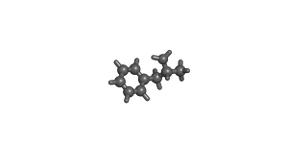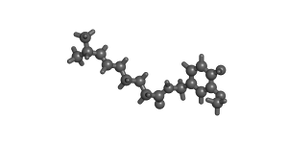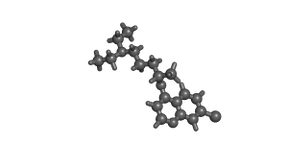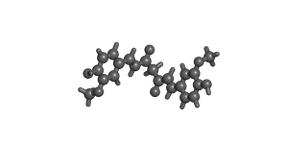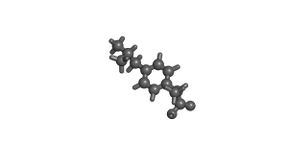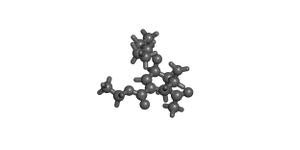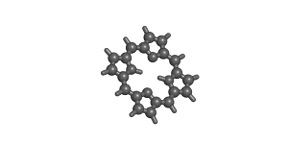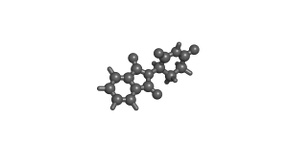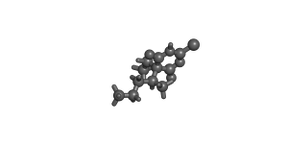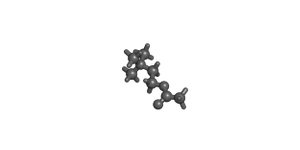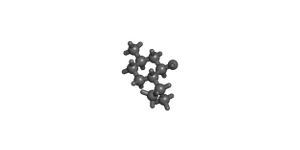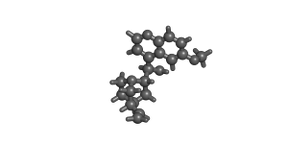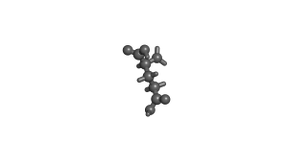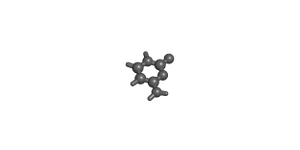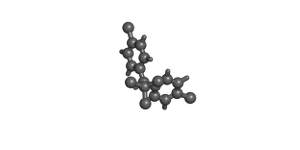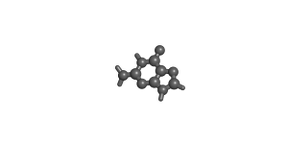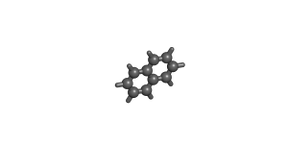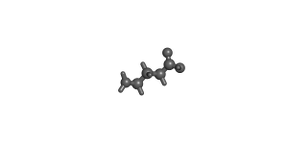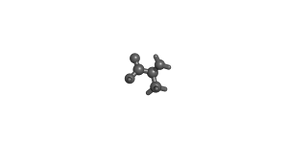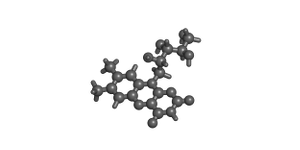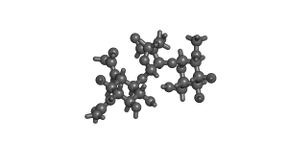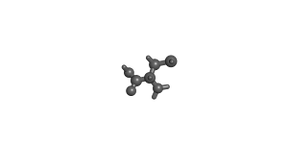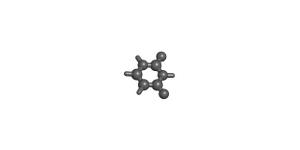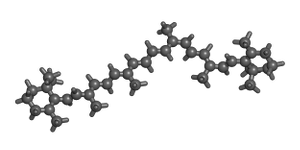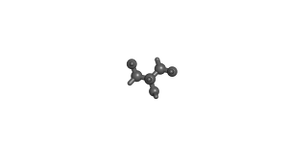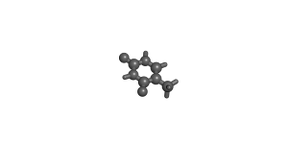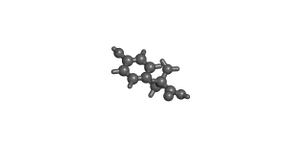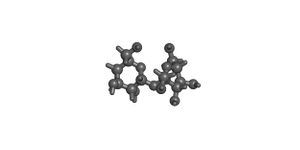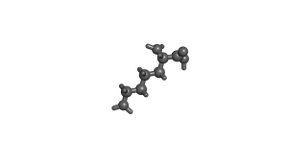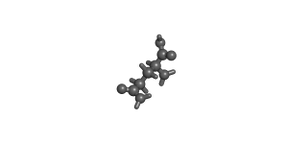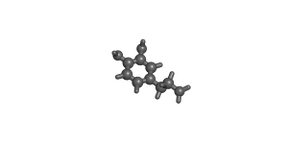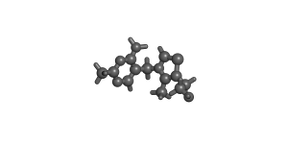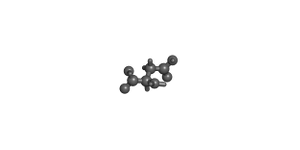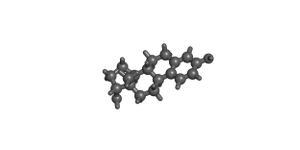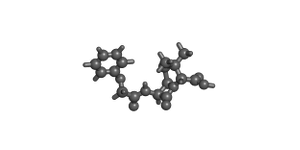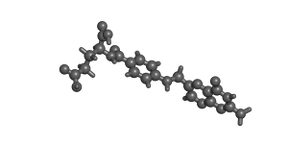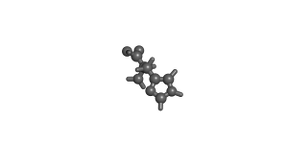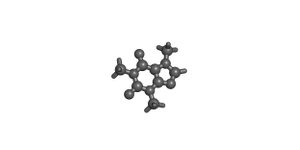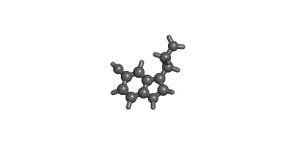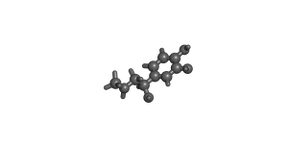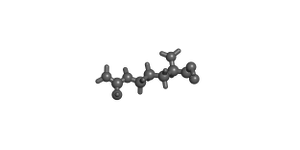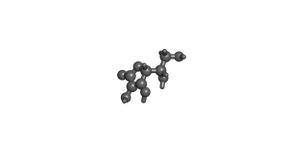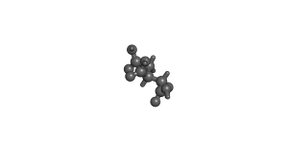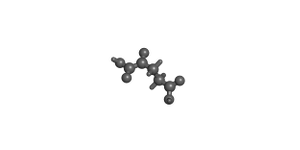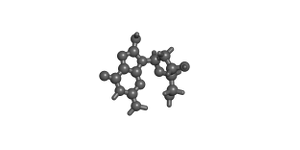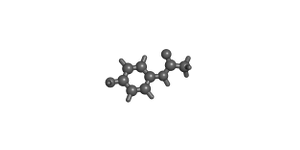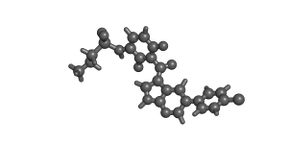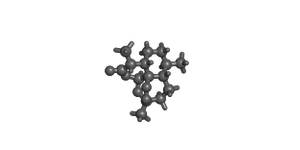The recent refurbishment of the Shared Facilities Building of our Hinxton campus has included the installation of a series of cladding panels in the refreshment facilities, made up of around 500 perforated metal plates depicting around 70 molecules. These were selected from a short list choosen by the ChEBI team and rendered in 3-Dimensional form by John May, a PhD student in Chemoinformatics and Metabolism team at EBI.
|
Amphetamine (contracted from alpha-methylphenethylamine) is a potent central
nervous system (CNS) stimulant of the phenethylamine class that is used in the treatment of attention
deficit hyperactivity disorder (ADHD) and narcolepsy. ...
more
|
Auranofin is a gold complex classified by the World Health Organization as an
antirheumatic agent. It has the brand name Ridaura. ...
more
|
Capsaicin (8-methyl-N-vanillyl-6-nonenamide) is an active component of chili
peppers, which are plants belonging to the genus Capsicum. It is an irritant for mammals, including humans,
and produces a sensation of burning in any tissue with which it comes into contact. ... more
|
|
Chloroquine is a 4-aminoquinoline drug used in the treatment or prevention
of malaria. ... more
|
Curcumin (pronounced "Kur kyoo min") is a diarylheptanoid. It is the
principal curcuminoid of the popular South Asian spice turmeric, which is a member of the ginger family
(Zingiberaceae). Turmeric's other two curcuminoids are desmethoxycurcumin and bis-desmethoxycurcumin. ... more
|
Glucose (also known as dextrose, or grape sugar) is a simple aldosic
monosaccharide found in plants. It is a monosaccharide that is absorbed directly into the bloodstream
during
digestion. It is an important carbohydrate in biology, which is indicated by the fact that cells use it
as a
secondary source of energy and a metabolic intermediate.
...
more
|
|
Ibuprofen (INN, BAN, AAN and USAN) (from isobutylphenylpropanoic acid)
is a
nonsteroidal anti-inflammatory drug (NSAID) derivative of propionic acid used for relieving pain,
helping
with fever and reducing inflammation. ... more
|
Oseltamivir INN, marketed under the trade name Tamiflu, is an antiviral
licensed to prevent or slow the spread of influenza A and influenza B (flu) virus between cells in the
body
by stopping the virus from chemically cutting ties with its host cell. ... more
|
Porphyrins are a group of heterocyclic macrocycle organic compounds,
composed of four modified pyrrole subunits interconnected at their α carbon atoms via methine
bridges
(=CH-). The parent porphyrin is porphine, and substituted porphines are called porphyrins. ... more
|
|
Thalidomide (from phthalimido-glutarimide. Currently marketed under the
brand names Immunoprin, Talidex, Talizer, Thalomid) is an immunomodulatory drug and the prototype of the
thalidomide class of drugs. It was first marketed in 1957 in West Germany under the trade-name
Contergan. ... more
|
thiopental sodium (CHEBI:9561)
Sodium thiopental, also known as Sodium Pentothal (a trademark of Abbott
Laboratories), thiopental, thiopentone, or Trapanal (also a trademark), is a rapid-onset short-acting
barbiturate general anesthetic that is an analogue of thiobarbital. Sodium thiopental is a core medicine
in
the World Health Organization's "Essential Drugs List", which is a list of minimum medical needs for a
basic
healthcare system. ... more
|
Coenzyme A (CoA, CoASH, or HSCoA) is a coenzyme, notable for its role in
the
synthesis and oxidation of fatty acids, and the oxidation of pyruvate in the citric acid cycle. All
genomes
sequenced to date encode enzymes that use coenzyme A as a substrate, and around 4% of cellular enzymes
use
it (or a thioester, such as acetyl-CoA) as a substrate.
... more
|
|
Acetylcholine (ACh, pron. ah-Seh-til-KO-leen) is an organic molecule
that
acts as a neurotransmitter in many organisms, including humans. It is an ester of acetic acid and
choline,
with chemical formula CH3COO(CH2)2N+(CH3)3 and systematic name 2-acetoxy-N,N,N-trimethylethanaminium. ... more
|
acetylsalicylic acid (CHEBI:15365)
Aspirin (BAN, USAN), also known as acetylsalicylic acid [ASA], is a
salicylate drug, often used as an analgesic to relieve minor aches and pains, as an antipyretic to
reduce
fever, and as an anti-inflammatory medication. ...
more
|
Menthol is an organic compound made synthetically or obtained from
cornmint,
peppermint or other mint oils. It is a waxy, crystalline substance, clear or white in color, which is
solid
at room temperature and melts slightly above. The main form of menthol occurring in nature is
(-)-menthol,
which is assigned the (1R,2S,5R) configuration. ...
more
|
|
Adenosine triphosphate (ATP) is a nucleoside triphosphate used in cells
as a
coenzyme, often called the "molecular unit of currency" of intracellular energy transfer.
ATP transports chemical energy within cells for metabolism. It is one of the end products of
photophosphorylation, cellular respiration, and fermentation and used by enzymes and structural proteins
in
many cellular processes, including biosynthetic reactions, motility, and cell division. ... more
|
Cephalosporin C is an antibiotic of the cephalosporin class. It was
isolated
from fungi of the genus Acremonium and first characterized in 1961. Although not a very active
antibiotic
itself, synthetic analogs of cephalosporin C, such as cefalotin, became some of the first marketed
cephalosporin antibiotic drugs. ... more
|
Quinine (KWIN-een) is a natural white crystalline alkaloid having
antipyretic (fever-reducing), antimalarial, analgesic (painkilling), and anti-inflammatory properties
and a
bitter taste. It is a stereoisomer of quinidine, which, unlike quinine, is an antiarrhythmic. ... more
|
|
Glutamic acid (abbreviated as Glu or E) is one of the 20-23
proteinogenic
amino acids, and its codons are GAA and GAG. It is a non-essential amino acid. The carboxylate anions
and
salts of glutamic acid are known as glutamates. In neuroscience, glutamate is an important
neurotransmitter
that plays the principal role in neural activation.
... more
|
Cytosine (C) is one of the four main bases found in DNA and RNA, along
with
adenine, guanine, and thymine (uracil in RNA). It is a pyrimidine derivative, with a heterocyclic
aromatic
ring and two substituents attached (an amine group at position 4 and a keto group at position 2). ... more
|
Cholesterol, from the Ancient Greek chole- (bile) and stereos (solid)
followed by the chemical suffix -ol for an alcohol, is an organic molecule. It is a sterol (or modified
steroid), a lipid molecule and is biosynthesized by many animal cells because it is an essential
structural
component of animal cell membranes that is required to maintain both membrane structural integrity and
fluidity. ... more
|
|
DDT ("dichlorodiphenyltrichloroethane") is a colorless, crystalline,
tasteless and almost odorless organochloride known for its insecticidal properties. DDT has been
formulated
in almost every conceivable form, including solutions in xylene or petroleum distillates, emulsifiable
concentrates, water-wettable powders, granules, aerosols, smoke candles and charges for vaporizers and
lotions. ... more
|
Guanine (G, Gua) is one of the four main nucleobases found in the
nucleic
acids DNA and RNA, the others being adenine, cytosine, and thymine (uracil in RNA). In DNA, guanine is
paired with cytosine. With the formula C5H5N5O, guanine is a derivative of purine, consisting of a fused
pyrimidine-imidazole ring system with conjugated double bonds. ... more
|
Naphthalene is an organic compound with formula C
10H
8. It is the simplest polycyclic aromatic hydrocarbon, and is a white crystalline solid with a
characteristic odor that is detectable at concentrations as low as 0.08 ppm by mass. As an aromatic
hydrocarbon, naphthalene's structure consists of a fused pair of benzene rings. ... more
|
|
Adenine (A, Ade) is a nucleobase (a purine derivative) with a variety of
roles in biochemistry including cellular respiration, in the form of both the energy-rich adenosine
triphosphate (ATP) and the cofactors nicotinamide adenine dinucleotide (NAD) and flavin adenine
dinucleotide
(FAD), and protein synthesis, as a chemical component of DNA and RNA. ... more
|
γ-aminobutyric acid (CHEBI:16865)
γ-Aminobutyric acid (GABA) is the chief inhibitory
neurotransmitter in
the mammalian central nervous system. It plays the principal role in reducing neuronal excitability
throughout the nervous system. In humans, GABA is also directly responsible for the regulation of muscle
tone. ... more
|
Nicotinamide adenine dinucleotide (NAD) is a coenzyme found in all
living
cells. The compound is a dinucleotide, because it consists of two nucleotides joined through their
phosphate
groups. One nucleotide contains an adenine base and the other nicotinamide. ... more
|
|
Alanine (abbreviated as Ala or A) is an α-amino acid with the
chemical
formula CH3CH(NH2)COOH. The L-isomer is one of the 20 amino acids encoded by the genetic code. Its
codons
are GCU, GCC, GCA, and GCG. It is classified as a non-polar amino acid. L-Alanine is second only to
leucine
in rate of occurrence, accounting for 7. ... more
|
Riboflavin (vitamin B2) is part of the vitamin B group. It is central
component of the cofactors FAD and FMN and as such required for a variety of flavoprotein enzyme
reactions
including activation of other vitamins. It was formerly known as vitamin G. ... more
|
Progesterone (pregn-4-ene-3,20-dione; abbreviated as P4) is an
endogenous
steroid hormone involved in the menstrual cycle, pregnancy, and embryogenesis of humans and other
species.
It belongs to a group of steroid hormones called the progestogens, and is the major progestogen in the
body. ... more
|
|
Streptomycin is an antibiotic (antimycobacterial) drug, the first of a
class
of drugs called aminoglycosides to be discovered, and it was the first cure for tuberculosis. It is
derived
from the actinobacterium Streptomyces griseus. Streptomycin is a bactericidal antibiotic. ... more
|
Serine (abbreviated as Ser or S) is an amino acid with the formula
HO2CCH(NH2)CH2OH. It is one of the proteinogenic amino acids. Its codons in the genetic code are UCU,
UCC,
UCA, UCG, AGU and AGC. By virtue of the hydroxyl group, serine is classified as a polar amino acid. ... more
|
Phenylalanine (abbreviated as Phe or F) is an α-amino acid with
the
formula C6H5CH2CH(NH2)COOH. This essential amino acid is classified as nonpolar because of the
hydrophobic
nature of the benzyl side chain. L-Phenylalanine (LPA) is an electrically neutral amino acid used to
biochemically form proteins, coded for by DNA. ...
more
|
|
Testosterone is a steroid hormone from the androgen group and is found
in
mammals, reptiles, birds, and other vertebrates. In mammals, testosterone is secreted primarily by the
testicles of males and the ovaries of females, although small amounts are also secreted by the adrenal
glands. ... more
|
Cysteine (abbreviated as Cys or C) is an α-amino acid with the
chemical formula HO2CCH(NH2)CH2SH. It is a semi-essential amino acid, which means that it can be
biosynthesized in humans. It is encoded by the codons UGU and UGC. The thiol side chain in cysteine
often
participates in enzymatic reactions, serving as a nucleophile. ... more
|
Uracil (U) is one of the four nucleobases in the nucleic acid of RNA
that
are represented by the letters A, G, C and U. The others are adenine (A), cytosine (C), and guanine (G).
In
RNA, uracil binds to adenine via two hydrogen bonds. In DNA, the uracil nucleobase is replaced by
thymine. ... more
|
|
β-Carotene is a strongly colored red-orange pigment abundant in
plants
and fruits. It is an organic compound and chemically is classified as a hydrocarbon and specifically as
a
terpenoid (isoprenoid), reflecting its derivation from isoprene units. β-Carotene is biosynthesized
from geranylgeranyl pyrophosphate. ... more
|
Glycerol (also called glycerine or glycerin; see spelling differences)
is a
simple polyol (sugar alcohol) compound. It is a colorless, odorless, viscous liquid that is widely used
in
pharmaceutical formulations. Glycerol has three hydroxyl groups that are responsible for its solubility
in
water and its hygroscopic nature. ... more
|
Thymine (T, Thy) is one of the four nucleobases in the nucleic acid of
DNA
that are represented by the letters G-C-A-T. The others are adenine, guanine, and cytosine. Thymine is
also
known as 5-methyluracil, a pyrimidine nucleobase. In RNA, thymine is replaced by the nucleobase
uracil. ... more
|
|
Tyrosine (abbreviated as Tyr or Y) or 4-hydroxyphenylalanine, is one of
the
22 amino acids that are used by cells to synthesize proteins. Its codons are UAC and UAU. It is a
non-essential amino acid with a polar side group. The word "tyrosine" is from the Greek tyros, meaning
cheese, as it was first discovered in 1846 by German chemist Justus von Liebig in the protein casein
from
cheese. ... more
|
Sucrose is a sugar, the organic compound commonly known as table sugar,
cane
sugar, beet sugar or, usually, just sugar. Saccharose is an obsolete name for sugars in general,
especially
sucrose. A white, odorless, crystalline powder with a sweet taste, it is best known for its role in
food. ... more
|
Lysine (abbreviated as Lys or K) is an α-amino acid with the
chemical
formula HO2CCH(NH2)(CH2)4NH2. It is an essential amino acid for humans. Lysine's codons are AAA and AAG.
Lysine is a base, as are arginine and histidine. The ε-amino group often participates in
hydrogen
bonding and as a general base in catalysis. ... more
|
|
Glutamine (abbreviated as Gln or Q, and often called L-glutamine) is one
of
the 20 amino acids encoded by the standard genetic code. It is considered a conditionally essential
amino
acid. Its side-chain is an amide formed by replacing the side-chain hydroxyl of glutamic acid with an
amine
functional group, making it the amide of glutamic acid.
...
more
|
Dopamine (contracted from 3,4-dihydroxyphenethylamine) is a hormone and
neurotransmitter of the catecholamine and phenethylamine families that plays a number of important roles
in
the human brain and body. Its name derives from its chemical structure: it is an amine that is formed by
removing a carboxyl group from a molecule of L-DOPA. ...
more
|
Vanillin is a phenolic aldehyde, which is an organic compound with the
molecular formula C8H8O3. Its functional groups include aldehyde, hydroxyl, and ether. It is the primary
component of the extract of the vanilla bean. Synthetic vanillin, instead of natural vanilla extract, is
now
more often used as a flavoring agent in foods, beverages, and pharmaceuticals. ... more
|
|
Thiamine or thiamin or vitamin B1, named as the "thio-vitamine"
("sulfur-containing vitamin") is a water-soluble vitamin of the B complex. First named aneurin for the
detrimental neurological effects if not present in the diet, it was eventually assigned the generic
descriptor name vitamin B1. ... more
|
Aspartic acid (abbreviated as D-AA, Asp, or D) is an α-amino acid
with
the chemical formula HOOCCH(NH2)CH2COOH. The carboxylate anion and salts of aspartic acid are known as
aspartate. The L-isomer of aspartate is one of the 23 proteinogenic amino acids, i.e., the building
blocks
of proteins. Its codons are GAU and GAC. ...
more
|
Estradiol, or more precisely, 17β-estradiol, is a human sex hormone
and
steroid, and the primary female sex hormone. It is named for and is important in the regulation of the
estrous and menstrual female reproductive cycles. Estradiol is essential for the development and
maintenance
of female reproductive tissues but it also has important effects in many other tissues including bone. ... more
|
|
Proline (abbreviated as Pro or P) is an α-amino acid, one of the
twenty DNA-encoded amino acids. Its codons are CCU, CCC, CCA, and CCG. It is not an essential amino
acid,
which means that the human body can synthesize it. It is unique among the 20 protein-forming amino acids
in
that the amine nitrogen is bound to not one but two alkyl groups, thus making it a secondary amine. ... more
|
phenoxymethylpenicillin (CHEBI:27446)
Phenoxymethylpenicillin, commonly known as penicillin V, is an
antibiotic
useful for the treatment of a number of bacterial infections. It is a penicillin that is orally active.
It
is less active than benzylpenicillin (penicillin G) against Gram-negative bacteria. ... more
|
Folic acid or folate is a B vitamin. It is also referred to as vitamin
Ф, vitamin M, vitamin B9, vitamin Bc (or folacin), pteroyl-L-glutamic acid, and
pteroyl-L-glutamate .
The term folate is often used in the food supplement industry to denote a difference with folic acid; in
chemistry the term folate refers to the ion and folic acid to the protonated ion, which both co-exist in
water. ... more
|
|
5-methylcytosine (CHEBI:27551)
5-Methylcytosine is a methylated form of the DNA base cytosine that may
be
involved in the regulation of gene transcription. When cytosine is methylated, the DNA maintains the
same
sequence, but the expression of methylated genes can be altered (the study of this is part of the field
of
epigenetics). ... more
|
Histidine (abbreviated as His or H) is an α-amino acid with an
imidazole functional group. It is one of the 23 proteinogenic amino acids. Its codons are CAU and CAC.
Histidine was first isolated by German physician Albrecht Kossel in 1896. Histidine is an essential
amino
acid in humans and other mammals. ... more
|
Caffeine is a bitter, white crystalline xanthine alkaloid found in
various
seeds, leaves, nuts, and berries. The caffeine ingested by insects when they feed on these plant parts
functions as a natural pesticide that can paralyze and kill them. ... more
|
|
Tryptophan (IUPAC-IUBMB abbreviation: Trp or W; IUPAC abbreviation:
L-Trp or
D-Trp; sold for medical use as Tryptan) is one of the 22 standard amino acids and an essential amino
acid in
the human diet, as demonstrated by its growth effects on rats. It is encoded in the standard genetic
code as
the codon UGG. ... more
|
Serotonin or 5-hydroxytryptamine (5-HT) is a monoamine neurotransmitter.
Biochemically derived from tryptophan, serotonin is primarily found in the gastrointestinal tract (GI
tract), platelets, and the central nervous system (CNS) of animals, including humans. ... more
|
Epinephrine (also known as adrenaline, adrenalin, or β,3,4-trihydroxy-N-methylphenethylamine)
is a hormone and a neurotransmitter. Epinephrine and norepinephrine are two separate but related
hormones
secreted by the medulla of the adrenal glands. They are also produced at the ends of sympathetic nerve
fibres, where they serve as chemical mediators for conveying the nerve impulses to effector organs. ... more
|
|
Theobromine, formerly known as xantheose, is a bitter alkaloid of the
cacao
plant, with the chemical formula C7H8N4O2. It is found in chocolate, as well as in a number of other
foods,
including the leaves of the tea plant, and the kola (or cola) nut. It is classified as a xanthine
alkaloid,
which also includes the similar compounds theophylline and caffeine. ... more
|
Arginine (abbreviated as Arg or R) is an α-amino acid. It was
first
isolated in 1886. The L-form is one of the 20 most common natural amino acids. At the level of molecular
genetics, in the structure of the messenger ribonucleic acid mRNA, CGU, CGC, CGA, CGG, AGA, and AGG, are
the
triplets of nucleotide bases or codons that code for arginine during protein synthesis. ... more
|
Ascorbic acid is a naturally occurring organic compound with antioxidant
properties. It is a white solid, but impure samples can appear yellowish. It dissolves well in water to
give
mildly acidic solutions. Ascorbic acid is one form ("vitamer") of vitamin C. ... more
|
|
Isocitric acid is a protonated form of isocitrate, which is a substrate
of
the citric acid cycle. Isocitrate is formed from citrate with the help of the enzyme aconitase, and is
acted
upon by isocitrate dehydrogenase. Salts and esters of isocitric acid are known as isocitrates. ... more
|
2-oxoglutaric acid (CHEBI:30915)
α-Ketoglutaric acid is one of two ketone derivatives of glutaric
acid.
The term "ketoglutaric acid," when not further qualified, almost always refers to the alpha
variant. β-Ketoglutaric
acid varies only by the position of the ketone functional group, and is much less common. ... more
|
Saccharin is an artificial sweetener with effectively no food energy
which
is approximately 300 times as sweet as sucrose or table sugar, but has a bitter or metallic aftertaste,
especially at high concentrations. It is used to sweeten products such as drinks, candies, cookies,
medicines, and toothpaste. ... more
|
|
Pyruvic acid (CH3COCOOH) is an organic acid, has a carboxylic acid and a
ketone functional group, and is the simplest of the alpha-keto acids. The carboxylate (COO-) anion of
pyruvic acid, its Brønsted-Lowry conjugate base, CH3COCOO-, is known as pyruvate, and is a key
intersection in several metabolic pathways. ...
more
|
8-hydroxy-2'-deoxyguanosine (CHEBI:40304)
8-Oxo-2'-deoxyguanosine (8-oxo-dG) is an oxidized derivative of
deoxyguanosine. 8-oxo-dG is one of the major products of DNA oxidation. Concentrations of 8-oxo-dG
within a
cell are a measurement of oxidative stress.
... more
|
Imatinib (INN), marketed by Novartis as Gleevec (Canada, South Africa
and
the USA) or Glivec (Australia, Europe and Latin America), and sometimes referred to by its
investigational
name STI-571, is a tyrosine-kinase inhibitor used in the treatment of multiple cancers, most notably
Philadelphia chromosome-positive (Ph+) chronic myelogenous leukemia (CML). ... more
|
|
Paracetamol, also known as acetaminophen, or APAP, chemically named
N-acetyl-p-aminophenol, is a widely used over-the-counter analgesic (pain reliever) and antipyretic
(fever
reducer). Acetaminophen is the name adopted for this pharmacologic agent in the U. ... more
|
Vemurafenib (INN, marketed as Zelboraf) is a B-Raf enzyme inhibitor
developed by Plexxikon (now part of the Daiichi Sankyo group) and Genentech for the treatment of
late-stage
melanoma. The name "vemurafenib" comes from V600E mutated BRAF inhibition.
Vemurafenib received FDA approval for the treatment of late-stage melanoma on August 17, 2011, making it
the
first drug designed using fragment-based lead discovery to gain regulatory approval. ... more
|
(+)-artemisinin (CHEBI:223316)
Artemisinin, also known as Qinghaosu, and its derivatives are a group of
drugs that possess the most rapid action of all current drugs against Plasmodium falciparum malaria.
Treatments containing an artemisinin derivative (artemisinin-combination therapies, ACTs) are now
standard
treatment worldwide for P. falciparum malaria. ...
more
|
|
Glucose (also known as dextrose, or grape sugar) is a simple aldosic
monosaccharide found in plants. It is a monosaccharide that is absorbed directly into the bloodstream
during
digestion. It is an important carbohydrate in biology, which is indicated by the fact that cells use it
as a
secondary source of energy and a metabolic intermediate.
...
more
|


